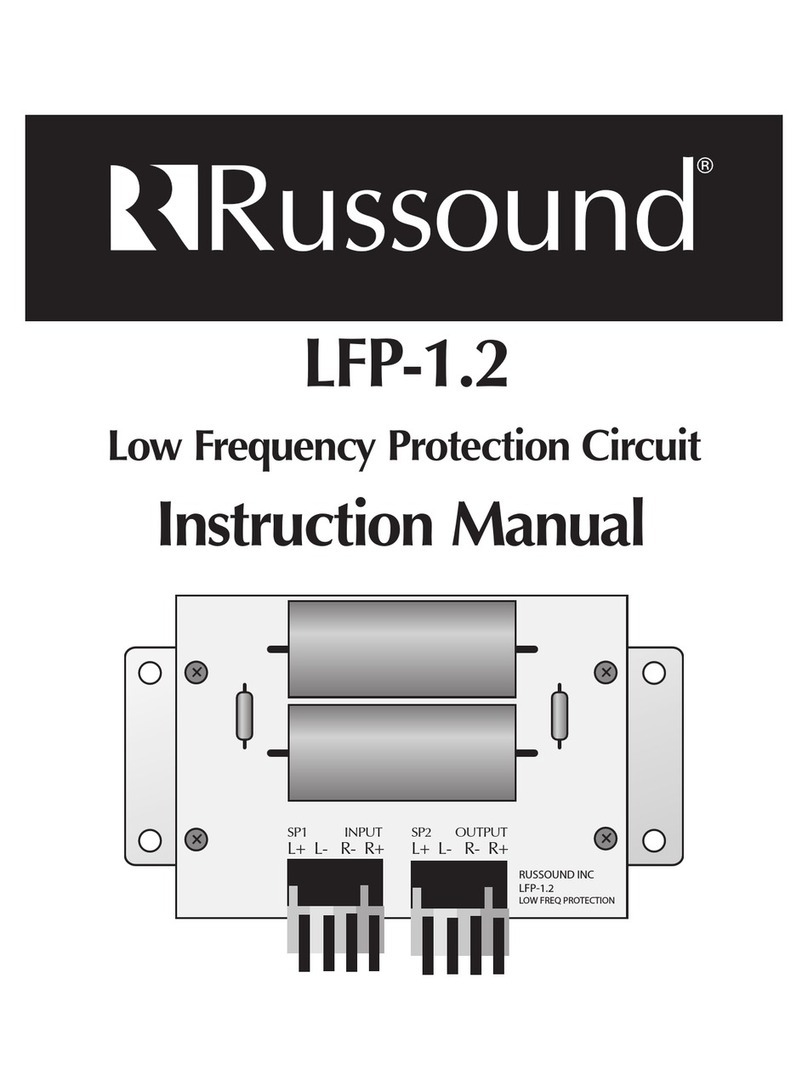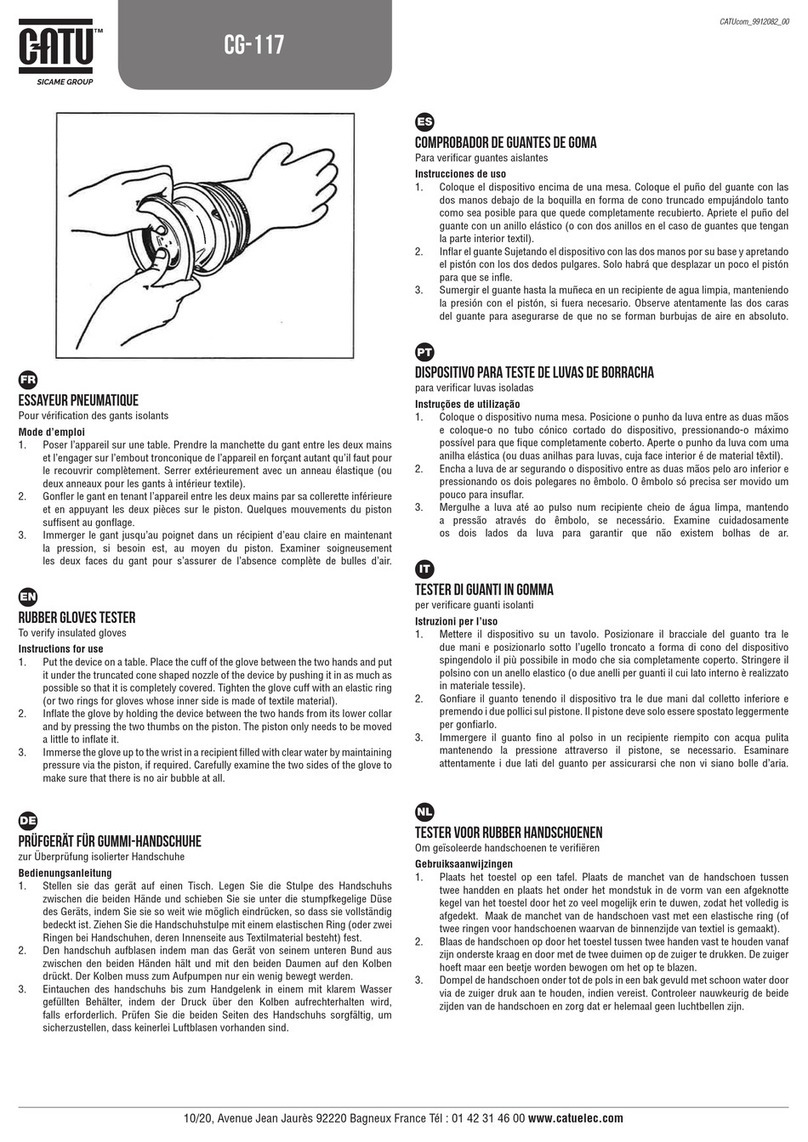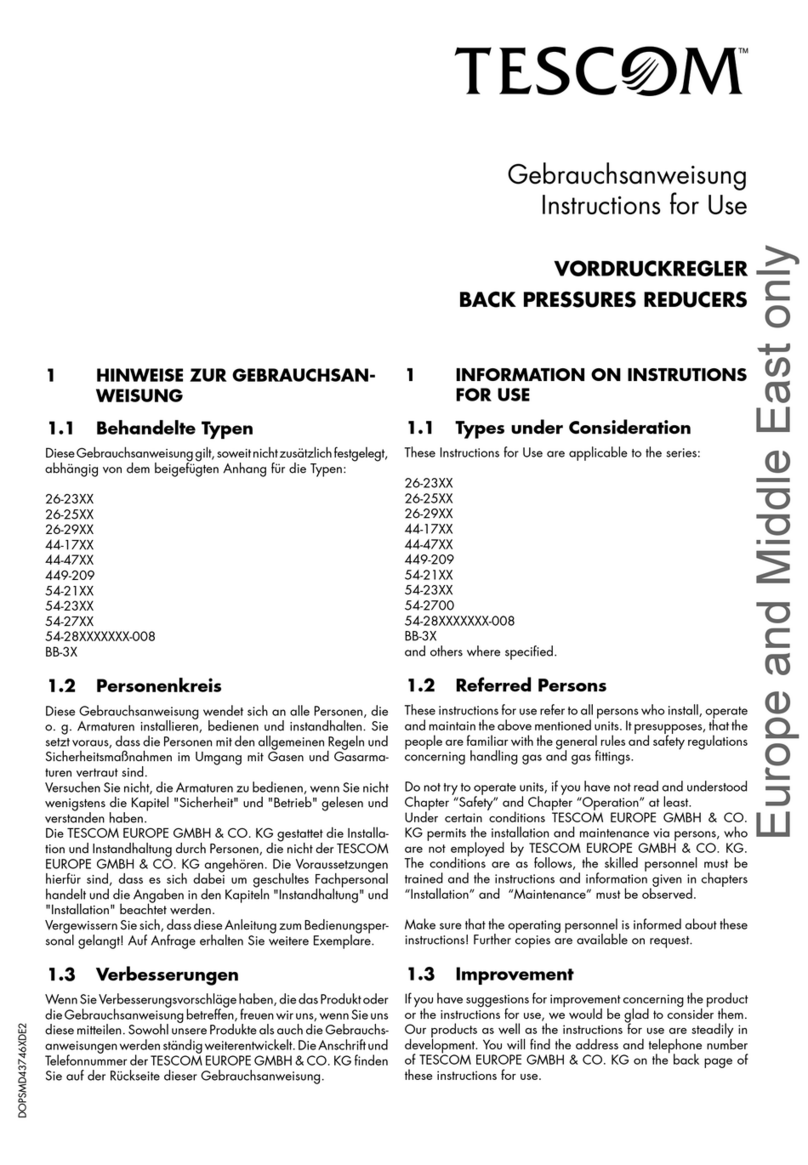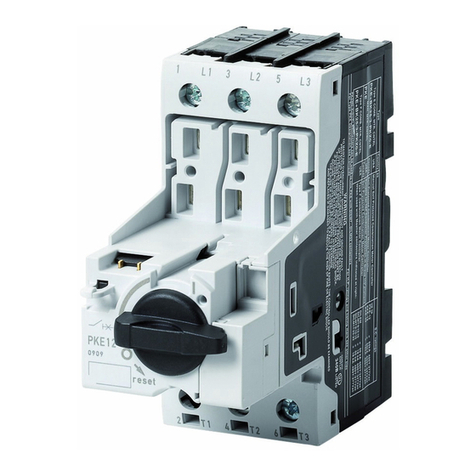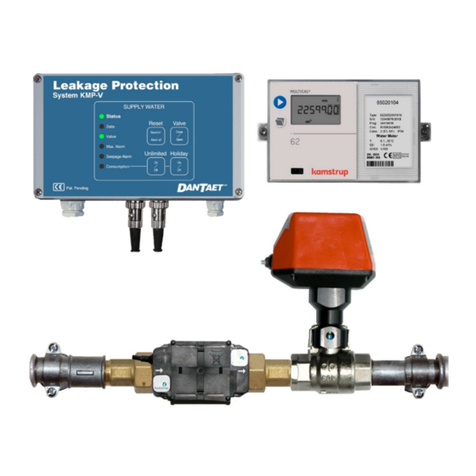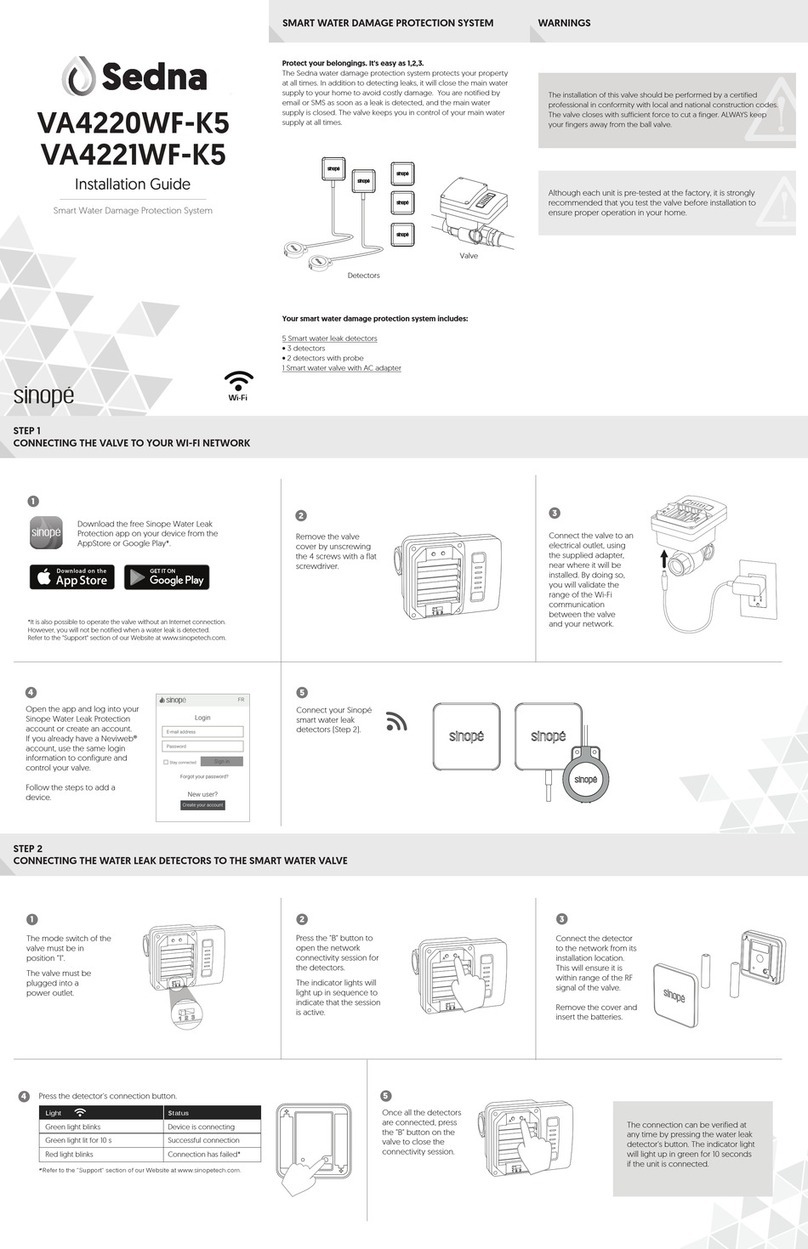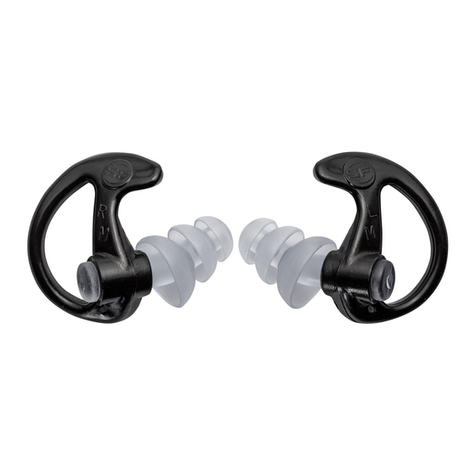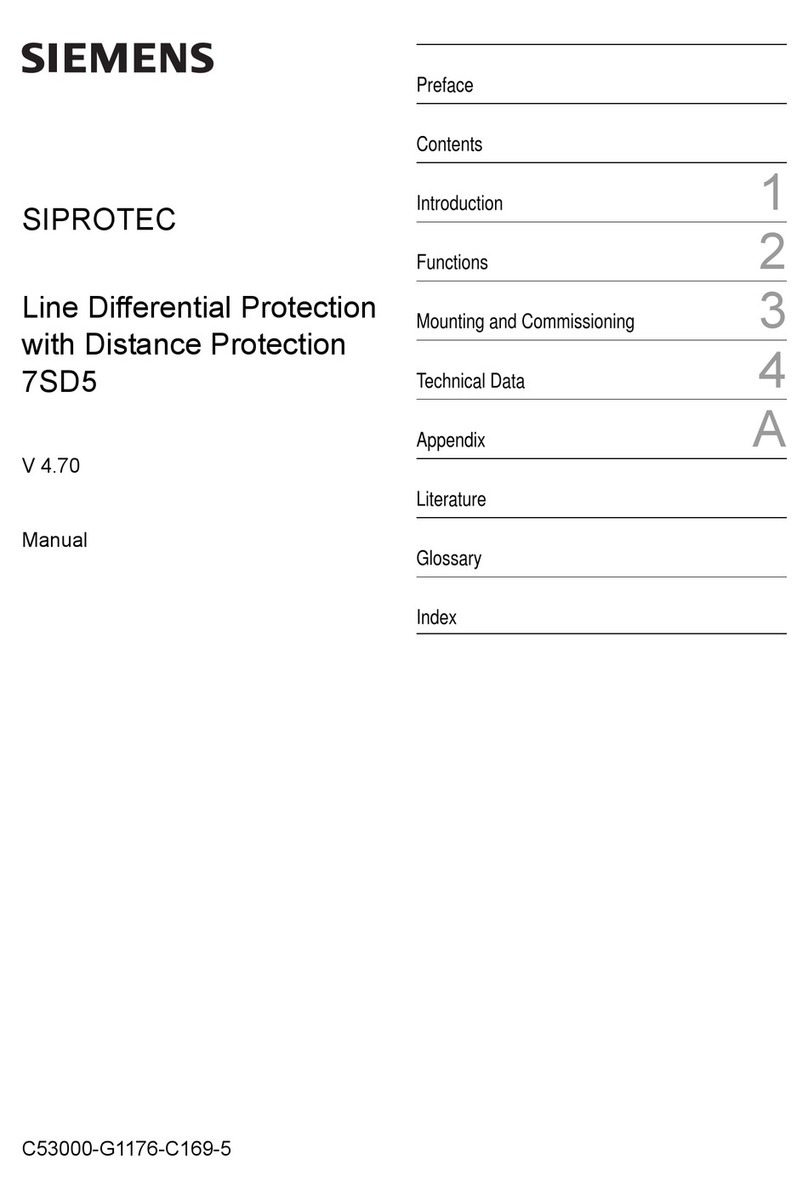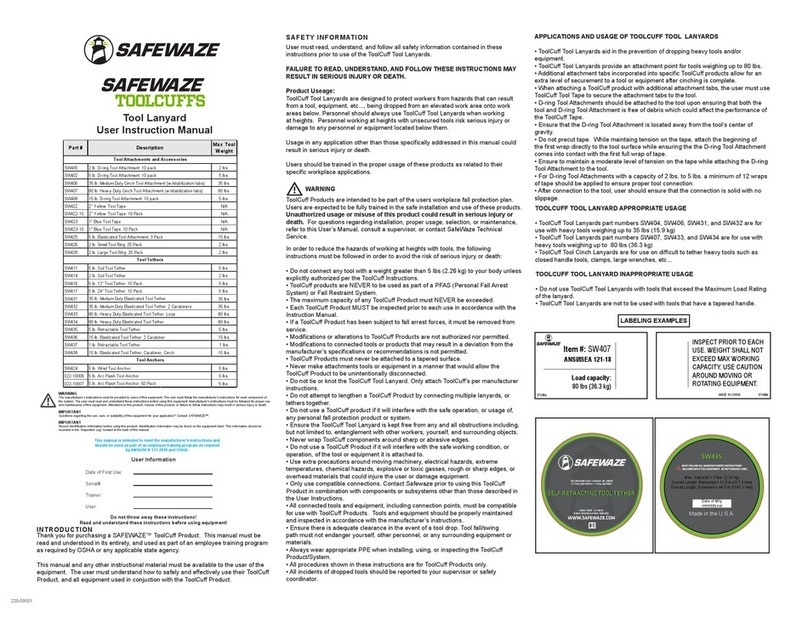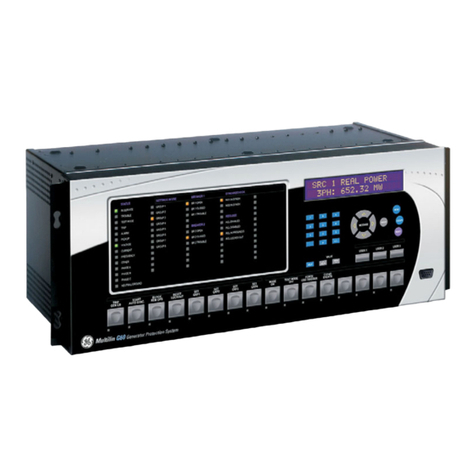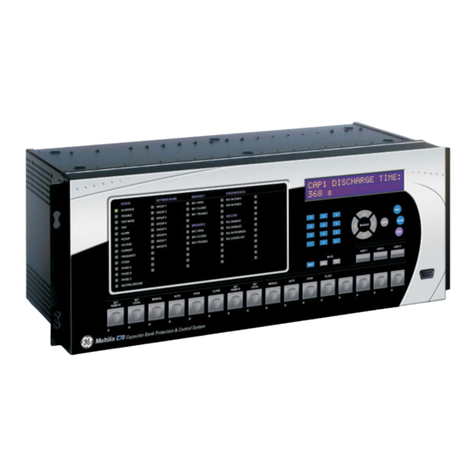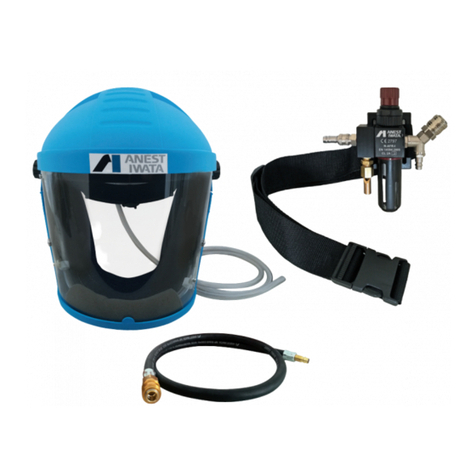STI UM Series User manual

. . . . .
R
SCIENTIFIC TECHNOLOGIES INC.
Call: 1/888/510-4357 in USA and Canada
Universal Safety Mat UM Series Rev. C
© STI 08/2000
1
STI Universal Safety Mat— UM Series
Table of Contents
Section 1—
Important Safety Message
. . . . . . . . . . . . . . . . . . . . . . . . . . . . . . . . . . . . . . . . . . . . page 2
Section 2—
Introduction
. . . . . . . . . . . . . . . . . . . . . . . . . . . . . . . . . . . . . . . . . . . . . . . . . . . . . . . page 3
Section 3—
Mat Construction
. . . . . . . . . . . . . . . . . . . . . . . . . . . . . . . . . . . . . . . . . . . . . . . . . . . page 4
Section 4—
Selecting The Safety Mat Size
. . . . . . . . . . . . . . . . . . . . . . . . . . . . . . . . . . . . . . . . . page 6
Section 5—
Safety Mounting Distance
. . . . . . . . . . . . . . . . . . . . . . . . . . . . . . . . . . . . . . . . . . . . page 7
Section 6—
Installation
. . . . . . . . . . . . . . . . . . . . . . . . . . . . . . . . . . . . . . . . . . . . . . . . . . . . . . . . page 9
Section 7—
Warranty
. . . . . . . . . . . . . . . . . . . . . . . . . . . . . . . . . . . . . . . . . . . . . . . . . . . . . . . . page 16
Appendix A
—Comparison Between Good and Poor Installation Design
. . . . . . . . . . . . . . . . page 17

IMPORTANT SAFETY MESSAGE
About the Universal Safety Mat
1
SCIENTIFIC TECHNOLOGIES INC.
Call: 1/888/510-4357 in USA and Canada
Universal Safety Mat UM Series Rev. C
© STI 08/2000
2
R
1 I
MPORTANT
S
AFETY
M
ESSAGE
1
1.1. A
BOUT
THE
U
NIVERSAL
S
AFETY
M
AT
A presence sensing mat and controller are general purpose presence sensing devices designed to
guard personnel working around moving machinery. The use of this type of guarding system is
regulated by government safety agencies. Please contact STI in California, USA at 510-608-3400 for
additional assistance.
Whether a specific machine application and presence sensing mat and controller installation
complies with government regulations depends upon several items, including: the proper
application, installation, maintenance and operation of the presence sensing mat and controller.
These items are the sole responsibility of the purchaser, installer and employer.
The employer is also responsible for the selection and training of the personnel necessary to
properly install, operate and maintain the machine and its safeguarding systems. For example, the
presence sensing mat and controller should be installed, check out and maintained only by a
qualified person, as
“a person or persons who, by possession of a recognized degree or certificate of
professional training or who, by extensive knowledge, training and experience, has successfully
demonstrated the ability to solve problems relating to the subject matter and work.”
(ANSI B30.2-
1983)
The machine operator must notify management if the machine, tooling or safety devices are not
operating properly. Never use the machine if it or the safety equipment is not is proper working
order.
The following additional requirements must be met before using a safety mat and controller system:
• The machine on which the presence sensing mat and controller are installed must be capable of
stopping motion anywhere in its cycle or stroke. Never use a presence sensing mat and controller on a
power press with a full-revolution clutch.
• Do not use a presence sensing mat and controller:
– on any device with inconsistent stopping time or inadequate control devices or mechanisms.
– where the environment, such as corrosive chemicals, may degrade the performance of the
mat and/or controller.
– to initiate machine motion.
• When a presence sensing mat and controller are used as a safety device, the employer has the
responsibility to ensure that all applicable federal, state, and local requirements, rules, codes and
regulations are satisfied.
• All safety related machine control circuit elements, including pneumatic, electric or hydraulic
controls, must be control reliable as defined by ANSI B11.19-1990, 5.5, which states in part
“...the
device, system or interface shall be designed, constructed and installed such that a single
component failure within the device, interface or system shall not prevent normal stopping
action from taking place, but shall prevent a successive machine cycle...”
• All other machinery or equipment must meet OSHA standard 1910.212 for general machine guarding
plus any other applicable regulations, codes and standards.
• Additional guarding such as safety light curtains or mechanical guards may be required if the presence
sensing mat and controller do not protect all areas of entry to the point of operation hazard.

. . . . .
R
I
NTRODUCTION
What A Safety Mat Does
SCIENTIFIC TECHNOLOGIES INC.
Call: 1/888/510-4357 in USA and Canada
Universal Safety Mat UM Series Rev. C
© STI 08/2000
3
• All brakes and stopping mechanisms must be inspected regularly to ensure proper working order. If
the stopping mechanisms are not working properly, the machine may not stop safely even though the
presence sensing mat and controller are functioning properly.
• The STI Test Procedure must be performed at installation and after any maintenance, modification or
adjustment is performed on the machine controls or on the presence sensing mat and controller. The
Test Procedure is presented in this manual.
• Do not perform any test or repairs other than those outlined in this manual. All electrical wiring must
be installed in accordance with local electrical codes and regulations.
• The user must follow all procedures in this manual for proper operation of the MC3 controller.
The enforcement of these requirements is beyond STI’s control. The employer has the sole
responsibility to follow the preceding requirements and any procedures, conditions and
requirements specific to your machinery
2 I
NTRODUCTION
2
Warning!
Read and understand this manual prior to installing the safety mat.
2.1. W
HAT
A S
AFETY
M
AT
D
OES
STI Universal safety mats provide personnel safeguards around hazardous machinery.
The Universal safety mat monitors ingress to the covered hazardous area and allows unimpeded
access for machinery, handling equipment and operators.
2.2. T
HEORY
OF
O
PERATION
Multiple safety mats may be wired in series to form a complete floor-level guarding system. Each 4-
wire Universal safety mat operates on a low-power DC, or AC signal (depending on controller). A
signal is transmitted through the upper and lower plates separately via the two wires connected to
each plate. The signals through the Universal safety mats are monitored by the mat Controller.
When the Universal safety mat is not exposed to sufficient actuating force, the signals are
unimpaired. The output relays in the controller are energized permitting the guarded machine to
run.
When sufficient pressure is applied to the active mat area, the conductive plates touch causing the
output relays in the controller to de-energize and a stop signal is issued to the machine.
If a wire should break, separate from a plate, or become disconnected from the controller the output
relays in the controller will de-energize and a stop signal will be sent. Should the Universal safety
mat be punctured, the plates will short together in a similar manner as being stepped on guarded
machine. The controller will not restart until the punctured mat is replaced.
▲
!

MAT CONSTRUCTION
Internal workings
3
SCIENTIFIC TECHNOLOGIES INC.
Call: 1/888/510-4357 in USA and Canada
Universal Safety Mat UM Series Rev. C
© STI 08/2000
4
R
3 M
AT
C
ONSTRUCTION
3
3.1. I
NTERNAL
WORKINGS
The internal switch consists of two sheets of specially flat, 24-gauge galvanealed steel. This assembly
is then sealed in a chemically engineered, PVC (Polyvinyl Chloride) Resin. This configuration
insures high resistance to impact, load, rust and moisture. The active area extends to within 1/4 in.
(6.25mm) of a Universal safety mat’s overall length and width dimensions.
3.2. C
ABLES
The Universal safety mat has a four conductor cable with a PVC (Polyvinyl Chloride) jacket. Each
individual conductor is rated at 18 AWG, 16 strand, 300VAC. The cable has a 4 pin quick disconnect
fitting on the end of it for easy installation and replacement. The individual conductors inside the
cable are color coded. The black and blue conductors are connected to the bottom electrode plate.
The brown and white conductors are connected to the top electrode plate. Standard cable length is 5
meters.
If an installation does not require the use of a quick-disconnect connection, it may be cut from the
cable to expose the individual conductors.
3.3. T
RIM
3.3.1
P
ERIMETER
WARNING!
Employees must be instructed that the perimeter trim is not an active sensing
surface. Stepping only on the perimeter trim will not send a stop signal to the guarded machine.
Perimeter trim is used to provide mechanical protection for the mat cables and to fix the mat(s) in
place as required by ANSI B11.19-1990. The perimeter trim of an individual or multiple mat
installation may be either aluminum or safety yellow PVC and is designed to fit securely to the 1/4
in. (6.25mm)edge of a mat.
The support legs of perimeter ramp trim extrusions are designed to act as a wire guide. This design
protects the mat cables from external damage after installation.
Blunt Trim is not designed with wire guides, and is only intended to keep the mats secured into
position.
European norm EN 1760-1:1997, Section 4.17 states, in part, “Where there is a danger that a person
can trip on the outside edge(s) of a sensor or sensor covering, a suitable ramp shall be provided. The
slope of the ramp shall not exceed 20 degrees from the horizontal.”
The aluminum Ramp Trim and the safety yellow PVC Trim (only available in ramp design) are sloped
at 19 degrees and measure 2 1/2 in. (62.5mm) wide. Aluminum Blunt Trim is 1 in. wide and should
be used only in installations where a tripping hazard does not exist, such as against a wall, machine
or mechanical guard.
STI CONTROLLER MODEL
Conductor Color SMC-1M6 SMC-2 MC3 MC4
Brown W1 S13 M12 Brown
Black B1 S23 M11 Black
Blue B2 S24 M21 Blue
White W2 S14 M22 White
▲
!

. . . . .
R
M
AT
C
ONSTRUCTION
Trim
SCIENTIFIC TECHNOLOGIES INC.
Call: 1/888/510-4357 in USA and Canada
Universal Safety Mat UM Series Rev. C
© STI 08/2000
5
3.3.2
A
CTIVE
J
OINING
T
RIM
When multiple Universal safety mats are required to cover an area, Active Joining Trim is required.
Active Joining Trim is comprised of Active Trim and Joining Strips.
Active Trim is cut to fit under and between two or more adjacent safety mats. It serves the dual
purpose of creating an active joint between mats and as a wireway for mat cables. Active Trim works
by transferring the weight of an object or personnel beyond the 1/4 in. (6.25mm) inactive area along
the edge of each mat to the active area of either one or both mats comprising the joint.
Active joining trim consists of two parts, an aluminum base that provides a wiring channel for two
mat cables and a black PVC cover providing protection for the cables and covering for the open area
between the mats.
Figure 3-1 Aluminum Blunt
Figure 3-2 PVC Trim with Aluminum Support
Figure 3-3 PVC Trim Corner 90°
Figure 3-4 PVC Trim Corner 270°
.540 REF
.540
1.00 REF
.425
Safety Mat
2.85
3.725
1.204
2.300
2.850
3.725
R2.85
1.204
2.300
Dimensions shown in inches
Side View
3.725
2.850
0.863
2.263
2.850
3.725
0.863
2.263
Dimensions are shown in inches
Side View

SELECTING THE SAFETY MAT SIZE
About The Mat Size
4
SCIENTIFIC TECHNOLOGIES INC.
Call: 1/888/510-4357 in USA and Canada
Universal Safety Mat UM Series Rev. C
© STI 08/2000
6
R
Figure 3-5 Active Joining Strip with Aluminum Base
Figure 3-6 Black PVC Cover for Active Joining Strip
4 S
ELECTING
T
HE
S
AFETY
M
AT
S
IZE
4
4.1. A
BOUT
T
HE
M
AT
S
IZE
According to ANSI B11.19-1990, “the size of the safety mat should be large enough to prevent entry
into the hazardous area. In some cases, this may require the use of more than one mat or additional
safeguarding.” (Section E4.2.5.2.1)
The safety mat must be of sufficient size to detect entry by an operator or others into a hazardous
area. Universal safety mats are available in a variety of standard sizes, call STI for sizes and
availability. If you need to identify an existing Universal safety mat, you may look in the STI catalog
for instructions on how to determine the model number, or call STI for assistance. Knowing the
distance that must be covered with safety mats from the hazardous area of the machine is critical to
a safe installation.
4.2. A
CTIVE
M
AT
S
URFACE
The Universal safety mat is designed to be secured to the mounting surface with the perimeter trim.
The mat has an inactive (non-sensing) area 1/4 in. (6.25mm) wide around the perimeter of the mat
at the edge. This inactive edge fits under the perimeter trim such that, with the trim installed, the
exposed surface of the mat is active.
Two or more mats placed adjacent to each other to form a large sensing area must use the Active
Joining Trim. The proper installation of the Active Joining Trim will create a fully active sensing
area in accordance with EN1760-1:1997.
CL
0.75 in.
0.275 in.
0.335 in.
0.275 in.
0.910 in.
4.000 in.
CL
0.650 in.
0.650 in.
0.324 in.

. . . . .
R
SAFETY MOUNTING DISTANCE
Determining the Safe Mounting Distance
SCIENTIFIC TECHNOLOGIES INC.
Call: 1/888/510-4357 in USA and Canada
Universal Safety Mat UM Series Rev. C
© STI 08/2000 7
Figure 4-1 Shows the Active Joining Strip System
5 S
AFETY
M
OUNTING
D
ISTANCE
5
5.1. DETERMINING THE SAFE MOUNTING DISTANCE
The sensing area must cover enough area from the hazardous area such that the machine will stop
before any part of the operator’s body can reach into the hazardous area. This distance, called the
safety distance, is a calculated number based on the stopping time of the machine to be guarded.
5.1.1 EN MINIMUM SAFE DISTANCE FORMULA
The following formula is based on the EN prEN999: method of calculating the minimum safe
distances for ground level trip devices.
The minimum safe distance shall be calculated using the following formula:S = (K x T) + C or
1. S=(63 in./sec. x T) + 47.2 in. - (0.4H) or
S=(1600mm/sec. x T) + 1200mm - (0.4H)
where:
S is the minimum distance in inches in the horizontal plane from the hazardous area to the
detecting edge of the device furthest from the hazardous area.
K = 63 in./sec. (1600mm/sec.), which is the average calculated approach speed.
T = t1+ t2
T is the overall system stopping performance,
t1 is the maximum time between the actuation of the safety mat and the controller output relays
being in the de-energized state.
t2is the response time of the machine being guarded. The time required to stop the machine or
remove the risk after receiving the output signal from the STI mat controller.
Wires
Active Trim
Joining Strip Mat Assembly
Inactive Area
*This drawing shows that the mat is operating with force being applied to the joining strip.

SAFETY MOUNTING DISTANCE
Approach Speeds and Stride Lengths
5
SCIENTIFIC TECHNOLOGIES INC.
Call: 1/888/510-4357 in USA and Canada
Universal Safety Mat UM Series Rev. C
© STI 08/2000 8
R
t1and t2are functions of the protective equipment and the machine respectively and are
determined by design.
C is an additional distance in inches, based on intrusion towards the danger zone prior to
actuation of the protective equipment.
C = 47.2 in. - (0.4H) or C = 1200mm - (0.4H)
47.2 in. (1200mm) is the average calculated stride length.
H is the distance above the reference plane in inches.
In most applications the safety mat will be mounted directly to the floor (H=0). Therefore the
minimum safe distance may be calculated as follows:
2. S=(63 in./sec. x T) + 47.2 in. or S=(1600mm./sec. x T) + 1200mm
If the safety mat is mounted on a step or raised platform, then the minimum safe distance must
be calculated using formula 1. above.
Example:
Given: (English Units)
The stopping time of the machine to be guarded is 0.300 seconds. The response time of the
controller is 0.025 seconds. The safety mat is to be mounted at the reference plane (floor).
S=(63 in./sec. x T) + 47.2 in. - (0.4H)
or
S=(63 in./sec. x (t1+t2)) + 47.2 in. - (0.4H)where T=t1+t2
Therefore:
S=(63 in./sec. x (0.300 sec.+0.025 sec.)) + 47.2 in. - (0.4 x 0.0 in.)
S=(63 in./sec. x 0.325 sec.) + 47.2 in. - 0.0 in.
S=20.48 in. + 47.2 in.
S=67.68 in.
5.2. APPROACH SPEEDS AND STRIDE LENGTHS
The positioning of safety mats, relative to the equipment they are guarding, is affected by approach
speed and stride length.
The approach speed and stride length is based on the physical and anthropometeric data of the
general public.
5.2.1 APPROACH SPEED
The approach speed is presumed to be that of persons at walking speed toward the hazardous area.
Approximately 3.5 mph or 5.75 kph.
5.2.2 STRIDE LENGTH
Data has shown that the 95th percentile of two steps (starting and finishing with the same foot)
measured from heel contact at walking speed is approximately 74.8 inches (1900 mm). By dividing
by 2 and subtracting the 5th percentile shoe length, this gives a stride length of 27.6 inches (700
mm). If it is assumed that an allowance has been made, for example, between the safety mat and the

. . . . .
R
INSTALLATION
Approach Speeds and Stride Lengths
SCIENTIFIC TECHNOLOGIES INC.
Call: 1/888/510-4357 in USA and Canada
Universal Safety Mat UM Series Rev. C
© STI 08/2000 9
stride length of , e.g. 1.97 inches (50 mm), this gives a minimum width of 29.5 inches (750 mm) for
the safety mat.
Figure 5-1 Examples of Safe Distance (S)
6 I
NSTALLATION
6
WARINING: Stacking safety mats after removal from packaging may affect the functionality of
the mats.
Note! The Universal safety mat is a durable activating device, providing it is properly handled and
installed. For dependable and long life of the safety mat, follow these instructions carefully.
Safety Mat S
Edge of
Hazardous
area
S
C
Reference plane
H = 0
S = Minimum Safe Distance
C = Stride Length Factor of Minimum Safe Distance Formula
▲
!

INSTALLATION
Safety Mat Installation
6
SCIENTIFIC TECHNOLOGIES INC.
Call: 1/888/510-4357 in USA and Canada
Universal Safety Mat UM Series Rev. C
© STI 08/2000 10
R
6.1. SAFETY MAT INSTALLATION
6.1.1 SURFACE PREPARATION
The surface on which the safety mat(s) will be placed should be flat, smooth and free of debris. Any
debris left under the mat, in time, may work its way through the PVC (Polyvinyl Chloride) housing
and eventually contact the electrode assembly. This may affect the mechanical switching of the
electrode assembly and will provide a path for moisture to enter the mat. These conditions may lead
to a mat failure.
6.1.2 LIFTING AND CARRYING THE UNIVERSAL SAFETY MAT
Hold opposites sides, if possible, while lifting and carrying a safety mat. (figure 5.1) A slight bow
along the length of the mat may be allowed. This will prevent the mat from bending across its width
which could cause a bend or kink in the electrode assembly.
Assistance may be required to lift, carry and install the larger safety mats. The weight of these mats
varies from 5 pounds (2.3 kg) to 100 pounds (45.25 Kg). The large size and flexibility of these mats
can be awkward to lift and carry alone.
Figure 6-1 Carry the Mat
6.1.3 PROPER CARE OF THE UNIVERSAL SAFETY MAT CABLES
After the mat is in place, use care in routing the mat cables to prevent damaging the insulation or
breaking the internal wires. Make sure that the cable passageways are free of burrs and sharp edges.
Where the mat cable is to enter the under the trim, the trim or mounting surface must be grooved
or notched so as not to pinch the cable when the trim is tightened down.
Unless extra precautions are taken to make a watertight connection, never make a cable splice at
floor level where the presence of moisture is a possibility. Moisture present at a non-watertight
connection will work through the cable and into the mat (i.e. capillary action or wicking).
6.1.4 SECURING THE UNIVERSAL SAFETY MAT TO THE FLOOR
ANSI B11.19-1990, Section E4.2.5.2.1 states, in part, “Whenever possible, the mat should be fixed in
place in such a manner so as to prevent easy relocation or removal by the operator or other
unauthorized personnel.”
A safety mat must be fixed in position to prevent its movement. A relocated mat may not be in
position to detect the operator, or other personnel, before reaching the hazard. Also, locate the
safety mat so it, in itself, does not create a hazard.
Pre-drill mounting holes into the perimeter trim as shown on the drawing in figure 5.2. Arrange the
mat(s), cables, trim system and wiremold into the desired final position. Check that all gaps are
closed and all components of the sensing area are snug and properly oriented. Use the pre-drilled

. . . . .
R
INSTALLATION
Safety Mat Installation
SCIENTIFIC TECHNOLOGIES INC.
Call: 1/888/510-4357 in USA and Canada
Universal Safety Mat UM Series Rev. C
© STI 08/2000 11
holes in perimeter trim as a template to mark drill points on the mounting surface. Never drill
through the safety mat! Any holes in the mat will destroy the seal, impair the reliable operation of
the mat and void the warranty. After marking drill points, remove perimeter trim and drill holes into
mounting surface (use a 3/16 inch or 5mm bit). Insert the supplied plastic anchors into the
mounting holes, position the perimeter trim pieces in alignment with the predrilled mounting holes
and secure to the mounting surface using the supplied Phillips head screws.
Refer to Appendix A - European Norm EN 1760-1:1997, Annex B (Informative) for illustrations of
proper vs. poor mat installation and recommendations to consider for all safety mat installations.
Figure 6-2 Universal Safety Mat with Molded Corners

INSTALLATION
Safety Mat Installation
6
SCIENTIFIC TECHNOLOGIES INC.
Call: 1/888/510-4357 in USA and Canada
Universal Safety Mat UM Series Rev. C
© STI 08/2000 12
R
Figure 6-3 Mat Installation Illustrating – Drilling and Countersinking Anchor bolts

. . . . .
R
INSTALLATION
Safety Mat Installation
SCIENTIFIC TECHNOLOGIES INC.
Call: 1/888/510-4357 in USA and Canada
Universal Safety Mat UM Series Rev. C
© STI 08/2000 13
Figure 6-4 Universal Safety Mat with Mitered Corners

INSTALLATION
Safety Mat Installation
6
SCIENTIFIC TECHNOLOGIES INC.
Call: 1/888/510-4357 in USA and Canada
Universal Safety Mat UM Series Rev. C
© STI 08/2000 14
R
Figure 6-5 Mat Installation Illustrating – For Metered Corners Mats

. . . . .
R
INSTALLATION
Operation of Air Equalization Valve
SCIENTIFIC TECHNOLOGIES INC.
Call: 1/888/510-4357 in USA and Canada
Universal Safety Mat UM Series Rev. C
© STI 08/2000 15
6.2. OPERATION OF AIR EQUALIZATION VALVE
6.2.1 PURPOSE
To allow Safety Mat to equalize with outside atmosphere pressure to insure proper mate operation.
6.2.2 USE
After mats have been properly installed, clear any debris from area around air equalization valve.
Open the air equalization valve with a standard screw driver by turning the air equalization valve
screw 1 1/2 turns counter clockwise. Do not remove screw.
Allow the air equalization valve to remain open for a minimum of 30 seconds. Do not stand on or
allow objects to be on the safety mat during this process.
After the mat has been equalized, close the air equalization valve by turning the air equalization
valve screw clockwise until securely closed. Do not over tighten.
Figure 6-6 Air Valve Instruction
R
TIGHTEN
LOOSEN
Label P/N 28607-0010 Rev.A
-Please refer to manual for detailed instruction
on how to use the air valve.
- Consulter le manuel pour tous renseigne-
ments concernant le fonctionnement de
la soupape pneumatique.
- Sírvase consultar el manual donde se
detallan las instrucciones sobre cómo
hacer funcionar la válvula de aire.
- Fare riferimento al manuale per
istruzioni dettagliate in merito al
funzionamento della valvola dell’aria.
- Ausführliche Hinweise zur Bedienung
des Luftventils sind der entsprechenden
Gebrauchsanweisung zu entnehmen.
IMPORTANT NOTICE
Read instruction manual for proper installation
methods and operation of air valve.
Instruction: After mat is installed open air valve
by rotating valve "counter clockwise" 1 1/2 revolutions,
let mat sit with valve open 30 seconds.
Close valve by rotating clockwise.
Do not over-torque valve.

WARRANTY
STI Product Warranty Information
7
SCIENTIFIC TECHNOLOGIES INC.
Call: 1/888/510-4357 in USA and Canada
Universal Safety Mat UM Series Rev. C
© STI 08/2000 16
R
7 W
ARRANTY
7
7.1. STI PRODUCT WARRANTY INFORMATION
STI warrants its products to be free from defects of material and workmanship and will, without
charge, replace or repair any equipment found defective upon inspection at its factory, provided the
equipment has been returned, transportation prepaid, within one year from date of installation and
not to exceed 18 months from date of factory shipment.
The foregoing warranty is in lieu of and excludes all other warranties not expressly set forth herein,
whether expressed or implied by operation of law or otherwise including but not limited to any
implied warranties of merchantability or fitness for a particular purpose. No representation or
warranty, express or implied, made by any sales representative, distributor, or other agent or
representative of STI which is not specifically set forth herein shall be binding upon STI. STI shall
not be liable for any incidental or consequential damages, losses or expenses directly or indirectly
arising from the sale, handling, improper application or use of the goods or from any other cause
relating thereto and STI’s liability hereunder, in any case, is expressly limited to the repair or
replacement (at STI’s option) of goods.
Warranty is specifically at the factory. Any on site service will be provided at the sole expense of the
purchaser at standard field service rates.
All associated equipment must be protected by properly rated electronic/electrical protection
devices. STI shall not be liable for any damage due to improper engineering or installation by the
purchaser or third parties. Proper installation, operation and maintenance of the product becomes
the responsibility of the user upon receipt of the product.
Returns and allowances must be authorized by STI in advance. STI will assign a Returned Goods
Authorization (RGA) number which must appear on all related papers and the outside of the
shipping carton. All returns are subject to the final review by STI. Returns are subject to restocking
charges as determined by STI.
WARNING! Any attempt to repair the Universal safety mat will void the warranty and may
render the mat unsafe for use.
NOTE! This publication has been carefully checked for accuracy and is believed to be fully
consistent with the products it describes. However, STI does not assume liability for the contents of
this publication; the examples used within or the use of any product described herein. STI reserves
the right to make changes to products and/or documentation without further notification.
▲
!

. . . . .
R
—COMPARISON BETWEEN GOOD AND POOR INSTALLATION DESIGN
STI Product Warranty Information
SCIENTIFIC TECHNOLOGIES INC.
Call: 1/888/510-4357 in USA and Canada
Universal Safety Mat UM Series Rev. C
© STI 08/2000 17
A
PPENDIX
A —C
OMPARISON
B
ETWEEN
G
OOD
AND
P
OOR
I
NSTALLATION
D
ESIGN
A.1. EXAMPLE OF GOOD MAT INSTALLATION.
1. Additional fixed guards are fitted which prevent access to the danger zone of the machinery.
2. The fixed guard is arranged and designed in such a way that there is no access to the danger
zone between the fixed guard and the sensors. The fixed guard permits access to the danger
zone through the sensors only.
3. A sloping cover plate prevents the operator standing at the side of the effective sensing field
and in the danger zone.
4. Sensors are properly installed.
5. The dead zones of the sensors are located in such a way that the protective function will not
be impaired.
6. The tripping hazard at the sensor edge is reduced by a ramp at the point of access. The ramp
may also protect connecting cables.
7. The cable trunking is installed at the outside of the fixed guard.
8. Reset button is located in a well protected location giving full visibility of the machine.
1
8
7
2
6
5
45
3

—COMPARISON BETWEEN GOOD AND POOR INSTALLATION
DESIGN
7
SCIENTIFIC TECHNOLOGIES INC.
Call: 1/888/510-4357 in USA and Canada
Universal Safety Mat UM Series Rev. C
© STI 08/2000 18
R
A.2. EXAMPLE OF POOR INSTALLATION.
1. Fixed guards to the danger zone are not sufficient.
2. The danger zone is not protected from the rear and is accessible by reaching over and under
the fixed guard which is too small.
3. The operator can stand on the machinery base plate in the danger zone.
4. The sensors are not properly fixed.
5. The dead zones of the sensors are located in such a way that the operator may be able to
reach the danger zone.
6. Tripping hazards presented by exposed edges of sensors and trailing cables: trailing cables
are not protected against mechanical damage.
7. Cable trunking is installed on the inside of the fixed guard and may be misused to provide
access to the danger zone.
8. Sensors shall not be installed on traffic routes.
9. The service pipe installed above the sensors may be misused to swing over the sensors into
the danger zone.
10.The function and service life of the sensors will be reduced due to ground irregularities.
11.Access to the danger zone is provided by the baseplates of the fixed guard.
12.Sensor not fastened down and presenting a tripping hazard.
1
2
3
4
5
6
7
8
9
10
11
12
Table of contents
Other STI Protection Device manuals

STI
STI Euro Stopper STI-15000 Series User manual

STI
STI 6529 User manual

STI
STI STI-7560AC User manual

STI
STI SA5500 User manual
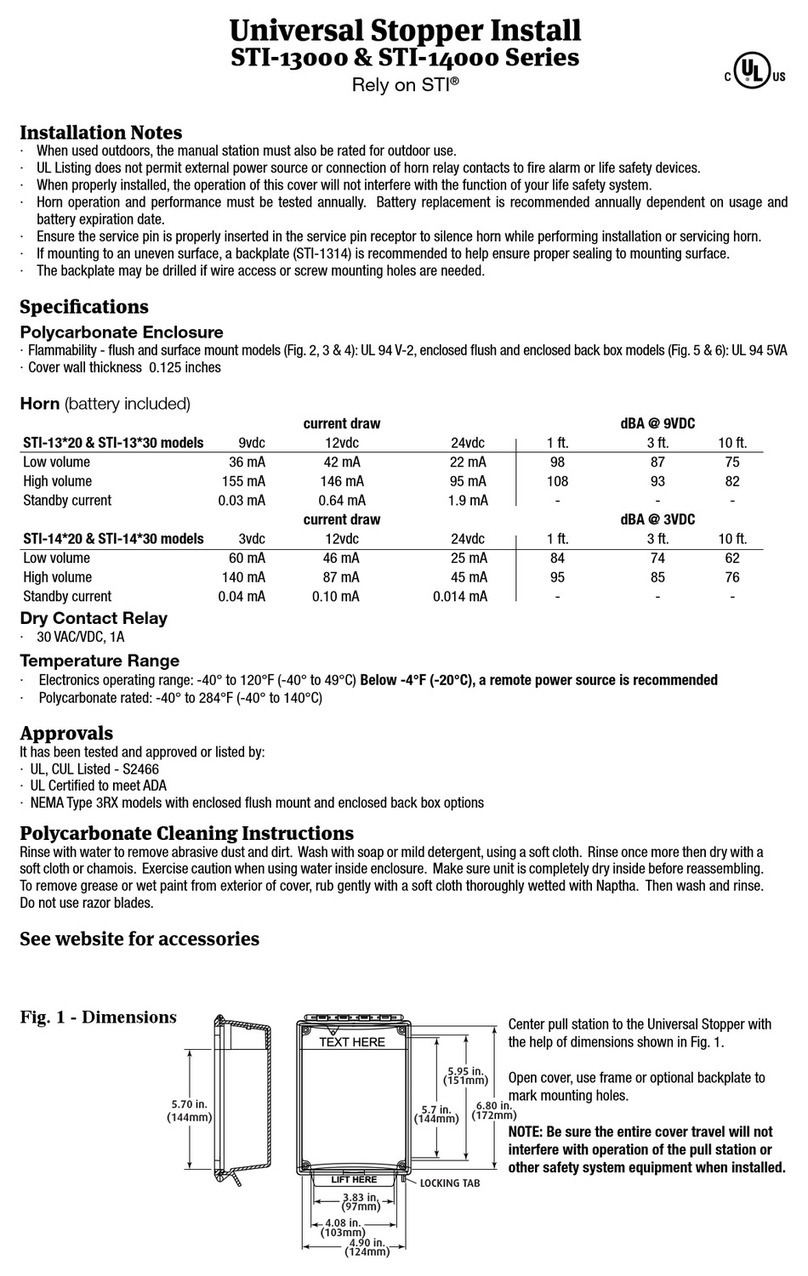
STI
STI STI-13000 Series Instruction sheet

STI
STI 13000 Series Instruction sheet

STI
STI Euro Stopper STI-15000 Series User manual
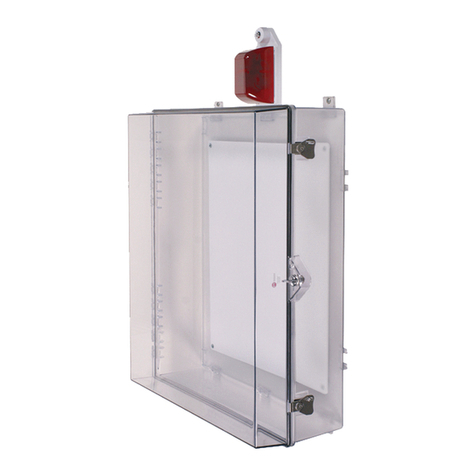
STI
STI STI-7554 User manual

STI
STI STI-6514 User manual
